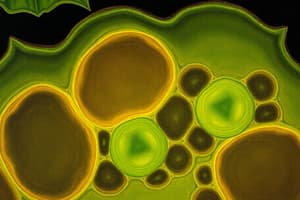Podcast
Questions and Answers
What is one primary role that plants play in the environment that directly supports animal life?
What is one primary role that plants play in the environment that directly supports animal life?
- Creating habitats for terrestrial animals
- Producing carbon dioxide for respiration
- Producing oxygen (correct)
- Absorbing heat from sunlight
Which statement about plant cell growth is accurate?
Which statement about plant cell growth is accurate?
- Plant cells grow predominantly through the whole body.
- Plant cells can only grow at a definite rate.
- Plant growth occurs indefinitely throughout their life. (correct)
- Plant growth is limited to specific seasons.
How do plants primarily respond to stimuli compared to animals?
How do plants primarily respond to stimuli compared to animals?
- Plants respond faster than animals due to their advanced nervous systems.
- Plants can quickly react due to their ability to move whole bodies.
- Plants have no specialized mechanisms for response. (correct)
- Plants utilize receptors to respond to environmental changes.
In which way do plant and animal cells differ in terms of waste excretion?
In which way do plant and animal cells differ in terms of waste excretion?
What is the primary function of the periderm in plants?
What is the primary function of the periderm in plants?
What is a significant difference in movement capabilities between plants and animals?
What is a significant difference in movement capabilities between plants and animals?
What role do plants play in beautifying environments?
What role do plants play in beautifying environments?
Which part of the plant is primarily involved in transporting food made in mature leaves?
Which part of the plant is primarily involved in transporting food made in mature leaves?
What distinguishes vessel elements from tracheids in xylem tissue?
What distinguishes vessel elements from tracheids in xylem tissue?
What is the function of ground tissue in dicot stems?
What is the function of ground tissue in dicot stems?
What occurs to chloroplasts as plants age or fruits ripen?
What occurs to chloroplasts as plants age or fruits ripen?
Which of the following is NOT a function of chloroplasts?
Which of the following is NOT a function of chloroplasts?
What role do the subterranean and aerial systems of plants play in their survival?
What role do the subterranean and aerial systems of plants play in their survival?
Which characteristic is true regarding the leaf structures of monocots and dicots?
Which characteristic is true regarding the leaf structures of monocots and dicots?
Which modification of plant leaves does not typically serve a photosynthetic function?
Which modification of plant leaves does not typically serve a photosynthetic function?
In what manner do monocots anchor themselves compared to dicots?
In what manner do monocots anchor themselves compared to dicots?
How do taxonomists differentiate between plant species based on their leaves?
How do taxonomists differentiate between plant species based on their leaves?
What is NOT a typical characteristic of compound leaves?
What is NOT a typical characteristic of compound leaves?
Which of the following statements about leaf functions is accurate?
Which of the following statements about leaf functions is accurate?
Which leaf adaptation is specifically designed to attract pollinators?
Which leaf adaptation is specifically designed to attract pollinators?
What primary role do taproots serve in addition to anchoring the plant?
What primary role do taproots serve in addition to anchoring the plant?
What characteristic of root hairs enhances their function in water and mineral absorption?
What characteristic of root hairs enhances their function in water and mineral absorption?
Which type of roots do corn plants possess that help support their tall stems?
Which type of roots do corn plants possess that help support their tall stems?
What is the main function of apical meristem in shoots?
What is the main function of apical meristem in shoots?
What effect does the presence of a terminal bud have on axillary buds?
What effect does the presence of a terminal bud have on axillary buds?
What is the primary function of the epidermis in plant tissues?
What is the primary function of the epidermis in plant tissues?
What specialized structure of the epidermis helps roots retain water?
What specialized structure of the epidermis helps roots retain water?
Which structure represents the points at which leaves are attached on a stem?
Which structure represents the points at which leaves are attached on a stem?
What is a function of a plant’s shoot system?
What is a function of a plant’s shoot system?
What happens to axillary buds when the terminal bud is absent?
What happens to axillary buds when the terminal bud is absent?
Flashcards are hidden until you start studying
Study Notes
Plant Importance
- Plants are essential for life on Earth, providing food for humans and animals.
- They produce oxygen, regulate temperature, and improve air quality.
- Plants help slow wind speeds, provide habitats for wildlife, and beautify surroundings.
- They are a source of building materials, fuel, and paper products.
- Plants are also a source of medicines and dyes.
Plant vs Animal Cells
- Plant cells grow indefinitely, while animal cells have a finite growth period.
- Plant cells produce less waste products than animal cells.
- Animal cells have a more developed excretory system.
- Plant cells have lower respiration rates compared to animal cells.
- Animals are capable of whole-body movement, while plants are generally fixed.
- Animal cells have receptors and a nervous system; plants do not.
- Animals respond more quickly to stimuli than plants.
Plant Structure and Adaptation
- Plants have adapted to two environments: soil for water and minerals, and air for CO2 and light.
- Plants have evolved two systems: a subterranean root system and an aerial shoot system.
- Roots lack chloroplasts and depend on the shoot system for sugars and organic nutrients.
- The shoot system, including flowers, relies on water and minerals from the roots.
- Leaves are the primary photosynthetic organs, with a flattened blade and stalk.
- Leaf shapes, arrangements, and vein patterns are used for plant identification.
- Leaves can be adapted for various functions, including tendrils for climbing, spines for defense, and water storage.
Monocot and Dicot Plants
- Monocots have fibrous roots, which spread out and anchor them firmly.
- Dicots have taproot systems with a large vertical root and smaller lateral roots.
- Monocots have parallel veins in their leaves, while dicots have branched, netted veins.
- Both monocots and dicots have root hairs that increase the surface area for water and mineral absorption.
Root System
- Root hairs near the tips of roots are responsible for most water and mineral absorption.
- Adventitious roots can grow above ground from stems or leaves, providing support for the plant.
Shoot System
- Shoots consist of stems and leaves and can be vegetative (leaf-bearing) or reproductive (flower-bearing).
- Stems have nodes (points of leaf attachment) and internodes (segments between nodes).
- Axillary buds at the leaf and stem junction can develop into vegetative branches.
- Terminal buds at the shoot apex contain apical meristem tissue, which produces differentiated tissues.
- Apical dominance inhibits axillary bud growth, promoting vertical growth for better light exposure.
Plant Tissue Systems
- Dermal Tissue: The outer protective layer of plants.
- The epidermis covers young plant parts and includes root hairs and a waxy cuticle.
- The periderm replaces the epidermis during growth, forming bark on trees.
- Vascular Tissue: Responsible for transporting substances within the plant.
- Xylem: Transports water and minerals upwards.
- Phloem: Transports sugars and other organic compounds.
- Ground Tissue: All other tissues in the plant.
- Functions include photosynthesis, storage, and support.
Plastids
- Chloroplasts: Double-membrane organelles responsible for photosynthesis.
- Contain chlorophyll, carotenoids, DNA, and other essential molecules.
- Function in protein synthesis, lipid production, and the synthesis of phytohormones, vitamins, and metabolites.
- Chromoplasts: Derived from chloroplasts, responsible for the colors of fruits, flowers, and roots.
- Accumulation of carotenoid pigments creates vibrant colors for attracting animals for seed dispersal.
Microscope Parts and Techniques
- Knowledge of microscope parts and techniques is essential for plant cell observation and analysis.
Carbohydrates as Reserved Nutrients
- Starch: The primary form of stored carbon in plants.
- Found as semi-crystalline granules composed of branched and linear glucose polymers.
- Starch granules vary in size and shape, aiding in plant identification.
- Simple Starch: Nuclei shaped like circles.
- Compound Starch: Has a line in the middle of the nucleus.
- Concentric Starch: Nucleus located in the center.
- Eccentric Starch: Nucleus located off-center.
Fats as Reserved Nutrients
- Storage lipids are accumulated in the embryo (cotyledons) or endosperm of seeds.
- Oilseeds store lipids mainly in their cotyledons.
Proteins as Reserved Nutrients
- Albumins: Water-soluble proteins found mainly in seeds.
- Globulins: Water-insoluble proteins commonly found in legume seeds.
- Prolamins and Glutelins: Proteins found in crop seeds, forming gluten.
- Aleurone: Protein granules found in maturing seeds and tubers.
- Present in the outermost layer of the endosperm, followed by the starchy endosperm.
Studying That Suits You
Use AI to generate personalized quizzes and flashcards to suit your learning preferences.




